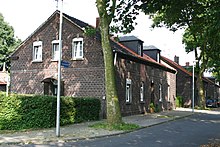Dunkelschlag settlement
The Dunkelschlag settlement is a former miners' settlement in Oberhausen - Sterkrade . The derivation of the name results from the immediate vicinity to the forest area Dunkelschlag .
The estate was built in 1904 by Gutehoffnungshütte to accommodate workers from the nearby new Sterkrade colliery . Initially 50 houses were built with the so-called cross floor plan, each containing four apartments with separate entrances. The individual apartments consisted of two rooms on the ground floor and two more on the upper floor. Toilets and stables were in separate buildings in the courtyard and garden area. Later acquisitions and new buildings increased the colony to 68 houses with 256 apartments. The streets newly laid out for the settlement still bear the descriptive names: ore, mine, shaft and mine streets. In addition, there is Dammstrasse, which runs parallel to the Oberhausen – Arnhem railway line . The first generation of residents came mainly from the eastern provinces of the German Empire and neighboring countries. As a result of the sinking of numerous new mines, the number of miners in the Oberhausen area rose sharply around 1900. While the proportion of East German and foreign workers in the workforce in the Oberhausen mining district was 15.7% in 1893, it rose to 54.6% by 1912.
At first there was tension between locals and immigrants; soon, however, a strong cohesion developed between the residents of the settlement, which increasingly came to be regarded as a "radical nest". Even during the Third Reich , it was a place of resistance - though more passive than active.
In the course of the gradual collapse of the collieries , which began in the 1950s, the occupational and age structure of the settlement population changed significantly. In 1985, 73 retired couples, 55 miners widows, 6 widowers and 72 active miners lived there, half of whom were foreign residents.
When mining damage led to the demolition of individual houses in the early 1980s , a citizens' initiative successfully campaigned for the preservation of the settlement, which was placed under monument protection in 1987. The settlement gained a certain regional fame through stories from long-time resident Johann Grohnke , some of which were published with the support of Janne and Roland Günter . Today it is part of the Route of Industrial Culture .
literature
- Johann Grohnke: Dunkelschlag - past and present of a settlement. In: Folk culture on the Rhine and Maas. Volume 8 1989, pp. 44-55.
- Johann Grohnke: Life in the Dark. Stories from a workers' settlement . Rheinland-Verlag, Cologne 1992, ISBN 3-7927-1303-9 .
- Peter Kersken: In the shadow of the colliery . Detective novel. ISBN 978-3-89705-714-2 . (Action takes place in the Dunkelschlagsiedlung)
Individual evidence
- ^ Wilhelm Seipp: Oberhausener Heimatbuch. Oberhausen 1964, p. 384.
- ^ Wilhelm Seipp: Oberhausener Heimatbuch. Oberhausen 1964, p. 383.
- ^ Roland Günter, Janne Günter: The unknown Oberhausen. Wuppertal 1983, p. 41.
- ↑ Johann Grohnke, Ernst Grafen: Memories of my dark fall colony. ( Memento from December 21, 2007 in the web archive archive.today )
Web links
- Description of this sight on the route of industrial culture
- Dunkelschlag settlement in Sterkrade; In: KuLaDig, Kultur.Landschaft.Digital. (Accessed: July 28, 2020)
Coordinates: 51 ° 32 ' N , 6 ° 50' E





